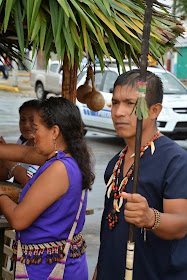In the Amazonian rainforest’s remote areas, the tradition of drinking chicha has survived and it is part of the daily diet of Kichwas.
For breakfast, lunch, dinner or whenever one feels
thirsty or hungry, aswa, as it is called in Kichwa, is an essential part of
alimentation and culture.
Rich in nutriments and thanks to its satiating
properties, the fermented drink stands as a good alimentary complement or can
be the only food when there is nothing to eat at home.
In the Amazon the popular chichas, aswa, are made from chonta palm's fruits or yuca, or cassava root.
In the Amazon the popular chichas, aswa, are made from chonta palm's fruits or yuca, or cassava root.
Mostly dedicated to celebrations, the stronger chicha is the
favorite beverage when it comes to partying.
The main festivities of the community, when chicha flows
the most, are weddings, baptisms, festivities and mingas – community
work aimed at improving the village infrastructures such as the cleaning of
public places.
Harvesting the yuca
The ritual of preparing chicha is largely the
women’s business.
It all starts in the chakra, the rainforest garden
plantation of Amazonic Kichwas.
All the female members of the family, with their babies
comfortably nestled in a special piece of cloth at their back or in front of
them, join in harvesting the yucca (or manioc).
While the women are extracting the roots from the ground,
the children help their mothers and sisters, play around or sleep in hammocks
hanging between two trees.
To collect the roots, the women can use a simple wood
stick or the useful machete, they can also simply pull out the whole plant.
Then they separate the root from the trunk of the plant and
gathered it in a palm baskets or chikras, knitted bags.
To take the yuca home they lift the completely full
baskets and arrange their handles on their foreheads so that they can walk home
easily.
On their way, they will stop by a nearby river to clean
the roots.
Cooking time mostly depends on the quality of the fire but it usually takes approximately twenty to thirty minutes.
While the yuca is boiling, a small wooden canoe called batan is
gently cleaned.
Once ready, the steaming roots are poured into the canoe
and smashed with a big wooden pestle, to obtain an homogeneous paste.
Then, the essential work can be initiated.
The ritual of chicha
The women put a small ball of the warm preparation in the
mouth, chew it for about five minutes and spit it back in the canoe.
This process is to be repeated until the whole paste
becomes smooth and mushy.
It is when the fermentation comes into action thanks to
the enzymes present in the saliva that break down the root starch, turning it
into alcohol.
In a couple of days, a weak chicha, the aswa, is
obtained.
The longer the preparation is left, the stronger the
beverage will be.
To finalize the making process, a handful of pulp is
mixed with a bit of water to liquefy the chicha.
The result is an unctuous milky beverage with yoghurt
flavor.
And every visitor will be welcomed with a pilche of chicha.
Serving of chicha
To serve the chicha women take it from the batan with
their coconut pilches and offer the drink to the guest of family members.
According to Amazonic Kichwa tradition, only women’s
hands can touch chicha while preparing or serving it.
They move in lines from one person to another.
Offering the pilche and waiting for the person to finish
the drink so they can go and get more of the drink.
Only when everyone has had their share, a cup or few, of
chicha, can the eating start.
What is chicha?
In South and Central America, chicha is a fermented or
non-fermented beverage usually derived from maize.
Chicha includes corn beer known as
chicha de jora and non-alcoholic beverages.
Also different kinds of chichas can be made from manioc root (also called yuca or cassava), grape, apple or various other fruits.
A very popular chicha in the Amazon is made from chonta,or chonta palm’s fruits, and it is actually a palm beer.
It has always been considered a sacred beverage, a symbol
of fertility and celebrates the richness of the Pacha Mama (Mother
Nature).
According to some sources, the word chicha came
from the expression “chichabh co-pah”, which means beverage made from corn in
the cuna language, a dialect from Panama.
For centuries, chicha, a fermented beverage made
from cereals, fruits or roots, has been taken by various indigenous tribes in
many parts of South America.
All over the Ecuadorian Amazonian rainforest, the Kichwa communities
have been using fermented yuca roots – also called manioc.
In these areas, the traditional beverage is an intrinsic
part of their culture.













This is so interesting. I really enjoyed the history! Someday I hope to be able to try Chicha. Thanks for sharing with Share Your Cup.
ReplyDeletehugs,
Jann
I've read about chicha in several books but I have never seen such a detailed description of the process of making it. Thanks for sharing at Booknificent Thursday.
ReplyDeleteTina
Joanna Sormunen thanks for share this post on Kichwa. As I know these peoples are live near Galapagos and my friend was enjoyed this drink when he was there with his girl friend. He was also enjoyed their wildlife under a touring guide that he got from their local tour service providers as reachecuador.com
ReplyDelete